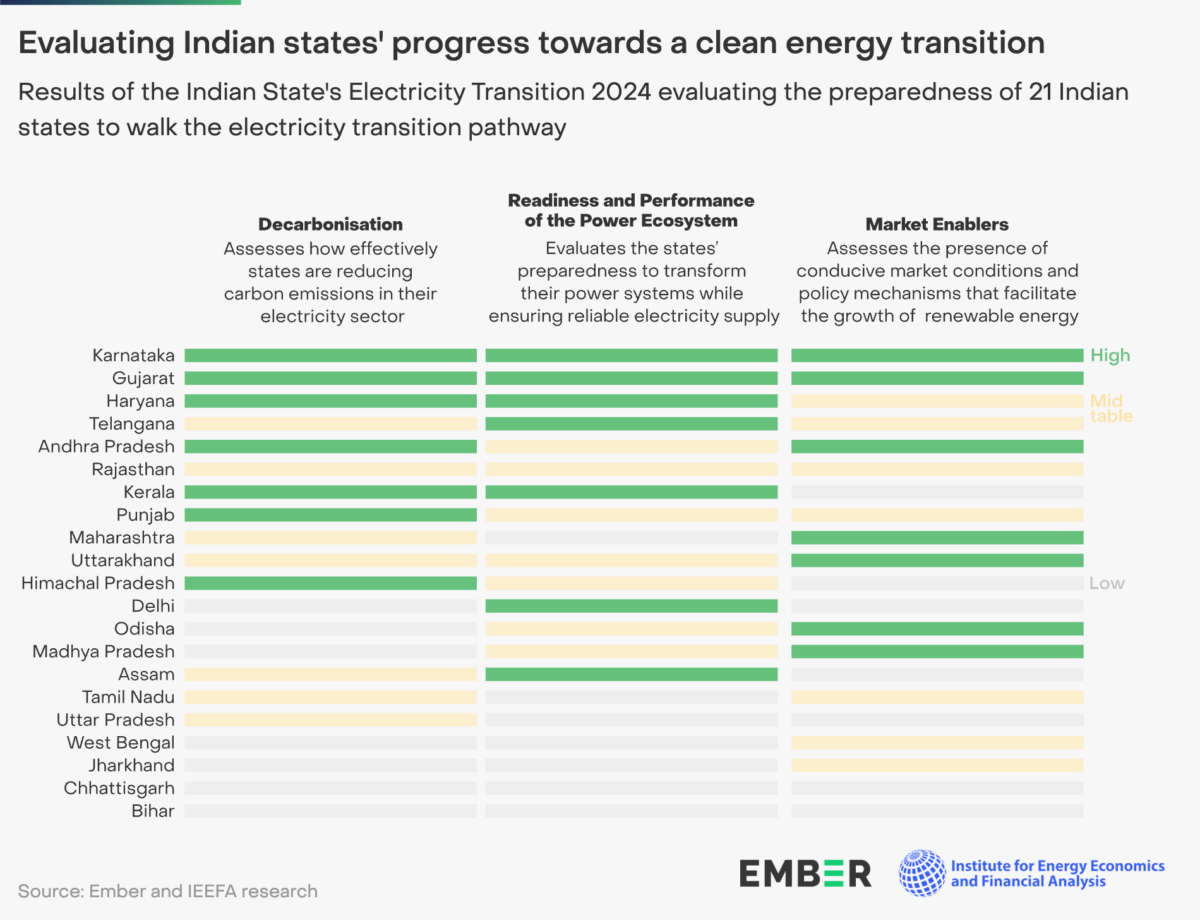Gujarat and Karnataka continue to lead transition toward clean energy, says a new joint report by the Institute for Energy Economics and Financial Analysis (IEEFA) and Ember. The report finds that Gujarat and Karnataka have effectively integrated renewable energy into their power sectors, shown adequate preparedness to further the electricity transition and have robust market enablers to facilitate future growth of clean electricity.
The Indian States’ Electricity Transition (SET) report evaluates the clean electricity transition preparedness in 21 Indian states representing about 95% of India’s annual power demand in the past seven financial years (FY) 2018 to 2024 (up to November).
The report states that the progress in states like Jharkhand, Bihar, West Bengal and Uttar Pradesh needs to improve. While these states are in the early stages of their transition, they now need to focus on increasing renewable energy deployment, enhancing short-term market participation and strengthening their distribution companies.
The report releases when temperatures in India have started to soar, leading to the Ministry of Power preparing for a projected peak power demand of 260 GW. Harsh summers also offer the chance to utilise more clean energy like solar power. Although, this requires the preparedness of states to transition to clean sources of electricity.
“Cyclical weather conditions coupled with faster economic activity is pushing India’s peak electricity demand higher every year. While the central government is taking steps to integrate more renewable energy into the grid, states, too, need to be prepared to do so. Gauging subnational progress now requires constant monitoring of several parameters at the state level. A purely national overview can often overshadow subtle intricacies at the state level, which may stymie the country’s electricity transition,” says the report’s contributing author, Vibhuti Garg, Director – South Asia, IEEFA.
The report finds that while the national-level progress towards the electricity transition is progressing well, it is far more uneven at the state level.
“Some states have developed progressive steps, such as boosting decentralised renewable energy deployment, promoting solar pumps for agricultural needs, and enhancing storage solutions to ensure more renewable energy in their electricity systems. But, the transition to clean electricity is still in its infancy in many states. These states should look to accelerate the efforts to access the benefits of a transition to clean electricity and to ensure that they are not left too far behind the better-performing states,” says the report’s contributing author, Aditya Lolla, Asia Programme Director, Ember.
Haryana plans to skyrocket its solar energy capacity by 22 times, installing 6 GW by 2030. States such as Uttar Pradesh, Rajasthan and Andhra Pradesh are the only ones with notified green hydrogen policies. Gujarat was set to unveil its green hydrogen policy last year, but it is still in the draft stages. Additionally, the Karnataka Energy Department has launched the state’s ambitious plan to transition millions of irrigation pumps to solar energy to save substantial amounts of money spent as a subsidy every year.
One of the striking findings from the analysis is that several states are exhibiting preparedness to embrace electricity transition. They perform well in the Readiness and Performance of the Power Ecosystem and Market Enablers dimensions but need to improve in the Decarbonisation dimension.
“Delhi’s power system is well-prepared for decarbonisation, while Odisha has robust market enablers to support decarbonisation in the power sector. However, their actual decarbonisation progress so far does not match their strengths in these aspects, highlighting the importance of performing well in both dimensions to effectively achieve decarbonisation goals,” says co-author Neshwin Rodrigues, Electricity Policy Analyst, Ember.
The report also notes that state-level decarbonisation can be further accelerated by strengthening the power ecosystem and having the right enablers. Some states that are decarbonising well also lack the right market enablers, others struggle with the readiness of their power ecosystems.
“Kerala, Haryana, Andhra Pradesh, Punjab and Maharashtra all exhibited considerable progress in certain aspects but also lower performance in other aspects. For example, Kerala and Punjab need to improve when it comes to market enablers for decarbonisation, while Andhra Pradesh and Maharashtra need to focus on the readiness of their power ecosystems,” says co-author Tanya Rana, Energy Analyst, IEEFA.
“Despite achieving relative success in decarbonising the sector thus far, states must address deficiencies in readiness and market enablers to sustain their momentum,” says Saloni Sachdeva Michael, Energy Specialist, India Clean Energy Transition, IEEFA.
This content is protected by copyright and may not be reused. If you want to cooperate with us and would like to reuse some of our content, please contact: editors@pv-magazine.com.









This article is a testament to the enduring power of literature to inspire, educate, and uplift, as the author weaves together themes of love, loss, and redemption with unmatched grace and poignancy.